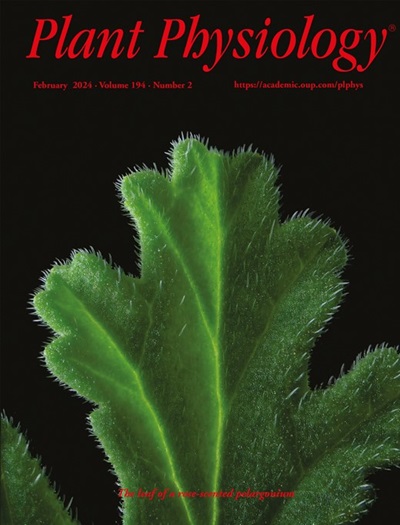The transcription factor ESR2/DRNL/BOL orchestrates cytokinin dynamics leading to developmental reprogramming and green callus formation
IF 6.9
1区 生物学
Q1 PLANT SCIENCES
引用次数: 0
Abstract
Callus formation and shoot regeneration are naturally triggered by stress and damage to the plant. They are also key components of tissue culture, which is crucial for gene editing, transformation, propagation, and other technologies in many species. Thus, the study of callus formation and shoot regeneration provides valuable insights into plant development. The transcription factor ENHANCER OF SHOOT REGENERATION 2/DORNROSCHEN-LIKE/BOLITA/SUPPRESSOR OF PHYTOCHROME B-4 2 (ESR2/DRNL/BOL/SOB2) promotes green callus formation in roots as well as shoot regeneration when overactive, and the phythormone cytokinin plays a prominent role in both processes. Yet, the role of ESR2 in the cytokinin pathway has not been previously described in Arabidopsis (Arabidopsis thaliana). We found that cytokinin content and the expression of the cytokinin biosynthesis gene ISOPENTENYLTRANSFERASE 5 (IPT5) are greater in plants with high ESR2 activity. ESR2 also regulates the cytokinin signaling repressor ARABIDOPSIS HISTIDINE PHOSPHOTRANSFER PROTEIN 6 (AHP6), and surprisingly, ESR2-stimulated green callus formation requires IPT5 and AHP6. Therefore, ESR2 promotes both cytokinin biosynthesis and the inhibition of cytokinin signaling and, paradoxically, requires a combination of these two effects for green callus induction. These findings provide a foundation to better understand the processes involved in tissue reprogramming towards callus formation and the role of ESR2 in callus formation and shoot regeneration.转录因子ESR2/DRNL/BOL协调细胞分裂素动力学,导致发育重编程和绿色愈伤组织形成
愈伤组织的形成和芽的再生是自然触发的压力和损害的植物。它们也是组织培养的关键组成部分,而组织培养对许多物种的基因编辑、转化、繁殖和其他技术至关重要。因此,对愈伤组织形成和茎部再生的研究为植物发育提供了有价值的见解。转录因子ENHANCER OF SHOOT REGENERATION 2/DORNROSCHEN-LIKE/BOLITA/SUPPRESSOR OF PHYTOCHROME B-4 2 (ESR2/DRNL/BOL/SOB2)在过度活跃时促进根的绿色愈伤组织形成和茎的再生,而phythone cytokinin在这两个过程中都起着突出的作用。然而,在拟南芥中,ESR2在细胞分裂素通路中的作用尚未被描述。我们发现,在ESR2活性高的植物中,细胞分裂素的含量和细胞分裂素生物合成基因IPT5的表达量更高。ESR2还调节细胞分裂素信号抑制因子拟南芥组氨酸磷酸转移蛋白6 (AHP6),令人惊讶的是,ESR2刺激的绿色愈伤组织形成需要IPT5和AHP6。因此,ESR2既促进细胞分裂素的生物合成,又抑制细胞分裂素的信号传导,矛盾的是,它需要这两种作用的结合才能诱导绿色愈伤组织。这些发现为更好地理解组织重编程导致愈伤组织形成的过程以及ESR2在愈伤组织形成和茎再生中的作用提供了基础。
本文章由计算机程序翻译,如有差异,请以英文原文为准。
求助全文
约1分钟内获得全文
求助全文
来源期刊

Plant Physiology
生物-植物科学
CiteScore
12.20
自引率
5.40%
发文量
535
审稿时长
2.3 months
期刊介绍:
Plant Physiology® is a distinguished and highly respected journal with a rich history dating back to its establishment in 1926. It stands as a leading international publication in the field of plant biology, covering a comprehensive range of topics from the molecular and structural aspects of plant life to systems biology and ecophysiology. Recognized as the most highly cited journal in plant sciences, Plant Physiology® is a testament to its commitment to excellence and the dissemination of groundbreaking research.
As the official publication of the American Society of Plant Biologists, Plant Physiology® upholds rigorous peer-review standards, ensuring that the scientific community receives the highest quality research. The journal releases 12 issues annually, providing a steady stream of new findings and insights to its readership.
 求助内容:
求助内容: 应助结果提醒方式:
应助结果提醒方式:


